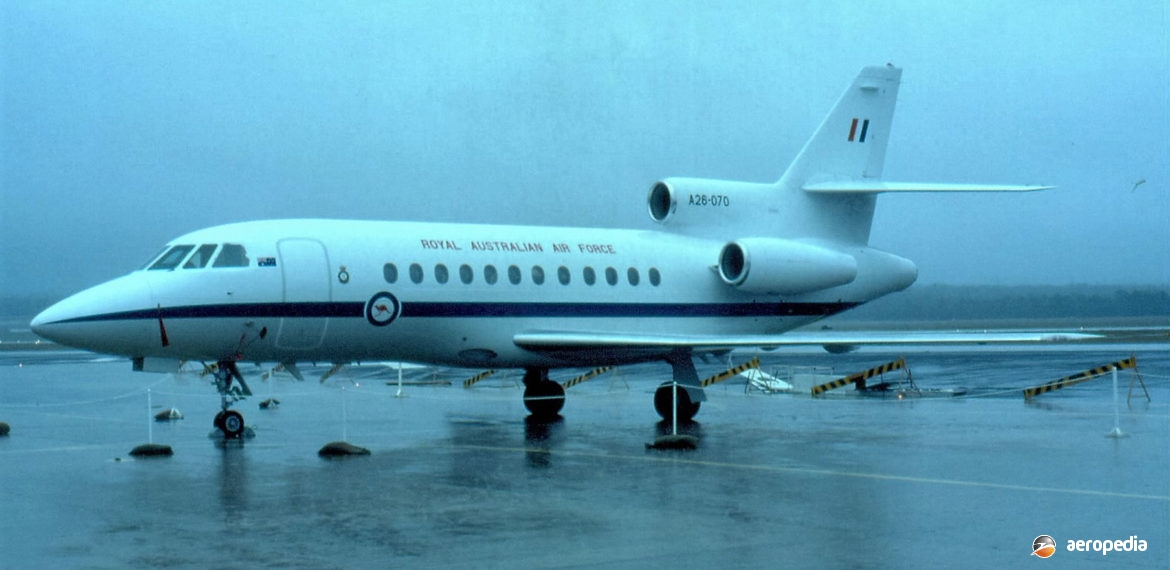Photograph:
Dassault-Breguet Falcon 900 A26-070 (c/n 70) of the RAAF VIP Flight at HMAS Albatross at Nowra, NSW in June 1991 (David C Eyre)
Country of origin:
France
Description:
Business and executive transport
Power Plant:
Three 4,500 lbst Garrett AiResearch TF731-5A-1C turbofans
Specifications:
- Wingspan: 19.33 m (63 ft 5 in)
- Length: 20.21 m (66 ft 3¼ in)
- Height: 7.55 m (24 ft 9¼ in)
- Wing area: 49.03 m² (527.75 sq ft)
- Max cruising speed at 11,890 m (39,000 ft): 892 km/h (554 mph)
- Range cruise at 11,275 m (37,000 ft): 797 km/h (495 mph)
- Max rate of climb: 1,158 m/min (3,800 ft/min)
- Stalling speed (clean): 193 km/h (120 mph)
- Stalling speed landing configuration: 152 km/h (94 mph)
- Max cruising height: 15,500 m (51,000 ft)
- Range with max payload IFR reserves: 4,444 km (2,761 miles)
- Range with 15 passengers at Mach 0.75 with max fuel and reserve: 6,780 km (4,213 miles)
- Range with 8 passengers with max fuel and reserve: 7,035 km (4,372 miles)
- Empty weight: 10,615 kg (23,400 lb)
- Loaded weight: 20,640 kg (45,500 lb)
- Max payload weight: 1,815 kg (4,000 lb)
History:
On 27 May 1983 Dassault-Breguet announced a program to develop an intercontinental three-turbofan executive transport to be known as the Mystere or Falcon 900. The prototype (F-WIDE), named ‘Spirit of Lafayette’, was rolled out of the assembly hall on 18 May 1984, and made its first flight on 21 September that year. The second development aircraft flew for the first time on 30 August 1985. Production commenced to meet 45 orders then on hand, and deliveries began in late 1986.
Of similar configuration to the Falcon 50 series, the Falcon 900 had increased overall dimensions, a larger fuselage, more powerful engines, and a better performance. Extensive use was made of carbon fibre and aramid composite (Kevlar) materials. Total fuel capacity was 10,735 litres (2,361 Imp gals). The fuselage was all-metal semi-monocoque fail-safe design and, by the use of thicker skins than on the Falcon 50, the number of frames was reduced from 43 to 35. The wing was designed with a profile optimised for a Mach 0.84 cruise, and was of conventional two-spar light alloy torsion box structure.
Various cabin configurations could be used to permit up to a maximum of 19 passengers. One configuration permitted an eight passenger layout, with a bedroom at the rear and three personnel seats forward. A 15 passenger layout permitted a VIP area at the rear and, for 18 passengers, three-abreast, airline-type seats could be fitted forward and a VIP lounge with two chairs and a settee to the rear. A Garrett GTC36-150 APU was installed in the rear fuselage and the pressurisation system maintained sea-level cabin environment up to 7,620 m (25,000 ft) and a cabin equivalent of 2,440 m (8,000 ft) at 15,500 m (51,000 ft).
Development of the series continued, and more than 200 aircraft were built. In 1991 production switched to the Falcon 900B, this differing from the earlier models in having AlliedSignal TFE731-5BR engines of 4,750 lbst, increased range, the ability to operate from unprepared strips, and Category II visibility approach clearance. This was followed by the Falcon 900EX, the first flight of which was made on 1 June 1995. This had 5,000 lbst AlliedeSignal TFE731-60 engines, a Honeywell Primus 4000 EFIS avionics suite, head-up display as an option, and increased fuel capacity for greater range. In late 1996 a Falcon 900EX made a record breaking 17,900 km (11,122 mile) flight from Sydney, NSW to Orlando, Florida with a single refuelling stop at Maui in Hawaii.
A number of examples of the Falcon 900 have been seen in this region. In 1989 the Australian Government leased five Falcon 900s to be operated by the RAAF’s No 34 Squadron VIP Flight for conveying senior members of parliament, etc, around Australia and overseas. These were: A26-070 (c/n 70) operated from September 1989 to April 2002 when it became VH-VIW before being exported as N105BK; A26-073 (c/n 073) operated from September 1989 to February 2002 when it became VH-WII before it was exported as N109BK; A26-074 (c/n 074) operated from October 1989 to October 2002 when it became VH-WIZ², being exported as N106BK; A26-076 (c/n 76) operated from November 1989 to July 2002 when it became VH-WIZ, being exported as N106BK; and A26-077 (c/n 77) operated from December 1989 to September 2002, when it became VH-WIM, being exported in October 2002 as N107BK.
In 1999 consideration was being given to replacing the Falcon 900s but in the event the Government decided to extend the lease and the aircraft continued to operate from RAAF Fairbairn, ACT until 2002 when they were replaced by two Boeing Business Jets and three Canadair Challengers.
Other Model 900s which have operated in this region have included: VH-BGF (c/n 5) operated by Bond Corporation from March 1987 to February 1990 when it was exported as F-GGRH; VH-BGV (c/32) operated from April 1988 to February 1990 also by Bond Corporation when it was exported as N800BL; VH-FCP (c/n – ex N41SJ) operated by Remorex Pty Ltd, becoming VH-ACE in August 1999; and VH-FHR (c/n 138) operated from August 2001 to March 2002 by Interair, being exported as C-FGFI.
Falcon Model 900Cs have included: VH-PPD (c/n 185) operated from October 2003 by Paspaley Pearling Company and VH-LAW (c/n 192) operated from November 2002 by Walker Corporation.

